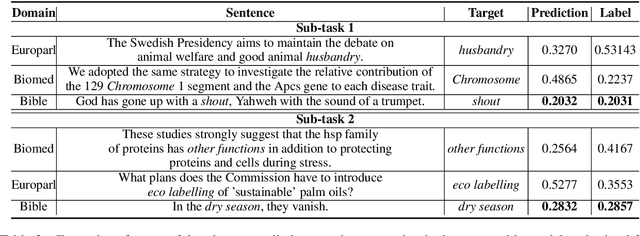Lis Kanashiro Pereira
Enhancing In-Context Learning with Semantic Representations for Relation Extraction
Jun 14, 2024



Abstract:In this work, we employ two AMR-enhanced semantic representations for ICL on RE: one that explores the AMR structure generated for a sentence at the subgraph level (shortest AMR path), and another that explores the full AMR structure generated for a sentence. In both cases, we demonstrate that all settings benefit from the fine-grained AMR's semantic structure. We evaluate our model on four RE datasets. Our results show that our model can outperform the GPT-based baselines, and achieve SOTA performance on two of the datasets, and competitive performance on the other two.
AcTED: Automatic Acquisition of Typical Event Duration for Semi-supervised Temporal Commonsense QA
Mar 27, 2024



Abstract:We propose a voting-driven semi-supervised approach to automatically acquire the typical duration of an event and use it as pseudo-labeled data. The human evaluation demonstrates that our pseudo labels exhibit surprisingly high accuracy and balanced coverage. In the temporal commonsense QA task, experimental results show that using only pseudo examples of 400 events, we achieve performance comparable to the existing BERT-based weakly supervised approaches that require a significant amount of training examples. When compared to the RoBERTa baselines, our best approach establishes state-of-the-art performance with a 7% improvement in Exact Match.
OCHADAI at SemEval-2022 Task 2: Adversarial Training for Multilingual Idiomaticity Detection
Jun 07, 2022


Abstract:We propose a multilingual adversarial training model for determining whether a sentence contains an idiomatic expression. Given that a key challenge with this task is the limited size of annotated data, our model relies on pre-trained contextual representations from different multi-lingual state-of-the-art transformer-based language models (i.e., multilingual BERT and XLM-RoBERTa), and on adversarial training, a training method for further enhancing model generalization and robustness. Without relying on any human-crafted features, knowledge bases, or additional datasets other than the target datasets, our model achieved competitive results and ranked 6th place in SubTask A (zero-shot) setting and 15th place in SubTask A (one-shot) setting.
* arXiv admin note: substantial text overlap with arXiv:2105.05535
OCHADAI-KYODAI at SemEval-2021 Task 1: Enhancing Model Generalization and Robustness for Lexical Complexity Prediction
May 13, 2021



Abstract:We propose an ensemble model for predicting the lexical complexity of words and multiword expressions (MWEs). The model receives as input a sentence with a target word or MWEand outputs its complexity score. Given that a key challenge with this task is the limited size of annotated data, our model relies on pretrained contextual representations from different state-of-the-art transformer-based language models (i.e., BERT and RoBERTa), and on a variety of training methods for further enhancing model generalization and robustness:multi-step fine-tuning and multi-task learning, and adversarial training. Additionally, we propose to enrich contextual representations by adding hand-crafted features during training. Our model achieved competitive results and ranked among the top-10 systems in both sub-tasks.
 Add to Chrome
Add to Chrome Add to Firefox
Add to Firefox Add to Edge
Add to Edge